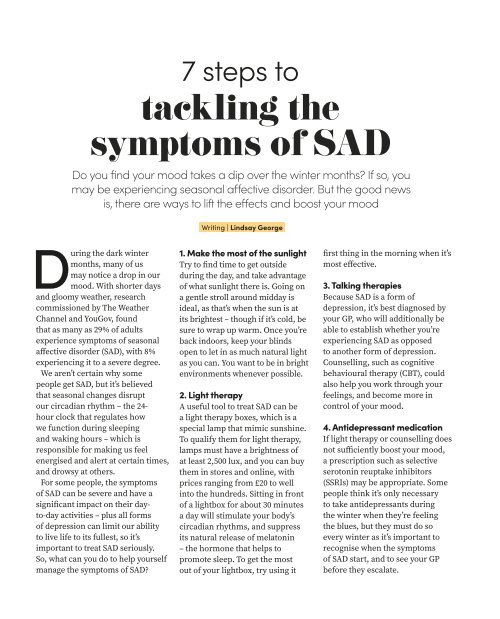Create successful ePaper yourself
Turn your PDF publications into a flip-book with our unique Google optimized e-Paper software.
7 steps to<br />
tackling the<br />
symptoms of SAD<br />
Do you find your mood takes a dip over the winter months? If so, you<br />
may be experiencing seasonal affective disorder. But the good news<br />
is, there are ways to lift the effects and boost your mood<br />
Writing | Lindsay George<br />
During the dark winter<br />
months, many of us<br />
may notice a drop in our<br />
mood. With shorter days<br />
and gloomy weather, research<br />
commissioned by The Weather<br />
Channel and YouGov, found<br />
that as many as 29% of adults<br />
experience symptoms of seasonal<br />
affective disorder (SAD), with 8%<br />
experiencing it to a severe degree.<br />
We aren’t certain why some<br />
people get SAD, but it’s believed<br />
that seasonal changes disrupt<br />
our circadian rhythm – the 24-<br />
hour clock that regulates how<br />
we function during sleeping<br />
and waking hours – which is<br />
responsible for making us feel<br />
energised and alert at certain times,<br />
and drowsy at others.<br />
For some people, the symptoms<br />
of SAD can be severe and have a<br />
significant impact on their dayto-day<br />
activities – plus all forms<br />
of depression can limit our ability<br />
to live life to its fullest, so it’s<br />
important to treat SAD seriously.<br />
So, what can you do to help yourself<br />
manage the symptoms of SAD?<br />
1. Make the most of the sunlight<br />
Try to find time to get outside<br />
during the day, and take advantage<br />
of what sunlight there is. Going on<br />
a gentle stroll around midday is<br />
ideal, as that’s when the sun is at<br />
its brightest – though if it’s cold, be<br />
sure to wrap up warm. Once you’re<br />
back indoors, keep your blinds<br />
open to let in as much natural light<br />
as you can. You want to be in bright<br />
environments whenever possible.<br />
2. Light therapy<br />
A useful tool to treat SAD can be<br />
a light therapy boxes, which is a<br />
special lamp that mimic sunshine.<br />
To qualify them for light therapy,<br />
lamps must have a brightness of<br />
at least 2,500 lux, and you can buy<br />
them in stores and online, with<br />
prices ranging from £20 to well<br />
into the hundreds. Sitting in front<br />
of a lightbox for about 30 minutes<br />
a day will stimulate your body’s<br />
circadian rhythms, and suppress<br />
its natural release of melatonin<br />
– the hormone that helps to<br />
promote sleep. To get the most<br />
out of your lightbox, try using it<br />
first thing in the morning when it’s<br />
most effective.<br />
3. Talking therapies<br />
Because SAD is a form of<br />
depression, it’s best diagnosed by<br />
your GP, who will additionally be<br />
able to establish whether you’re<br />
experiencing SAD as opposed<br />
to another form of depression.<br />
Counselling, such as cognitive<br />
behavioural therapy (CBT), could<br />
also help you work through your<br />
feelings, and become more in<br />
control of your mood.<br />
4. Antidepressant medication<br />
If light therapy or counselling does<br />
not sufficiently boost your mood,<br />
a prescription such as selective<br />
serotonin reuptake inhibitors<br />
(SSRIs) may be appropriate. Some<br />
people think it’s only necessary<br />
to take antidepressants during<br />
the winter when they’re feeling<br />
the blues, but they must do so<br />
every winter as it’s important to<br />
recognise when the symptoms<br />
of SAD start, and to see your GP<br />
before they escalate.

















